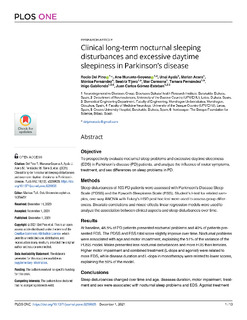| dc.rights.license | Attribution 4.0 International | * |
| dc.contributor.author | Ayala, Unai | |
| dc.contributor.other | del Pino, Rocío | |
| dc.contributor.other | Murueta Goyena, Ane | |
| dc.contributor.other | Acera, Marian | |
| dc.contributor.other | Fernández, Mónica | |
| dc.contributor.other | Tijero, Beatriz | |
| dc.contributor.other | Carmona, Mar | |
| dc.contributor.other | Fernández, Tamara | |
| dc.contributor.other | Gabilondo, Iñigo | |
| dc.contributor.other | Gómez Esteban, Juan Carlos | |
| dc.date.accessioned | 2022-02-15T14:34:00Z | |
| dc.date.available | 2022-02-15T14:34:00Z | |
| dc.date.issued | 2021 | |
| dc.identifier.issn | 1932-6203 | en |
| dc.identifier.other | https://katalogoa.mondragon.edu/janium-bin/janium_login_opac.pl?find&ficha_no=166827 | en |
| dc.identifier.uri | https://hdl.handle.net/20.500.11984/5463 | |
| dc.description.abstract | Objective
To prospectively evaluate nocturnal sleep problems and excessive daytime sleepiness (EDS) in Parkinson’s disease (PD) patients, and analyze the influence of motor symptoms, treatment, and sex differences on sleep problems in PD.
Methods
Sleep disturbances of 103 PD patients were assessed with Parkinson’s Disease Sleep Scale (PDSS) and the Epworth Sleepiness Scale (ESS). Student’s t-test for related samples, one-way ANOVA with Tukey’s HSD post hoc test were used to assess group differences. Bivariate correlations and mixed-effects linear regression models were used to analyze the association between clinical aspects and sleep disturbances over time.
Results
At baseline, 48.5% of PD patients presented nocturnal problems and 40% of patients presented EDS. The PDSS and ESS total score slightly improve over time. Nocturnal problems were associated with age and motor impartment, explaining the 51% of the variance of the PDSS model. Males presented less nocturnal disturbances and more EDS than females. Higher motor impairment and combined treatment (L-dopa and agonist) were related to more EDS, while disease duration and L-dopa in monotherapy were related to lower scores, explaining the 59% of the model.
Conclusions
Sleep disturbances changed over time and age, diseases duration, motor impairment, treatment and sex were associated with nocturnal sleep problems and EDS. Agonist treatment alone or in combination with L-dopa might predict worse daytime sleepiness, while L-dopa in monotherapy is related to lower EDS, which significantly affects the quality of life of PD patients. | en |
| dc.language.iso | eng | en |
| dc.publisher | PLOS | en |
| dc.rights | © 2021 Del Pino et al. | en |
| dc.rights.uri | http://creativecommons.org/licenses/by/4.0/ | * |
| dc.title | Clinical long-term nocturnal sleeping disturbances and excessive daytime sleepiness in Parkinson's disease | en |
| dcterms.accessRights | http://purl.org/coar/access_right/c_abf2 | en |
| dcterms.source | PLoS ONE | en |
| local.contributor.group | Teoría de la señal y comunicaciones | es |
| local.description.peerreviewed | true | en |
| local.identifier.doi | https://doi.org/10.1371/journal.pone.0259935 | en |
| local.contributor.otherinstitution | https://ror.org/0061s4v88 | es |
| local.contributor.otherinstitution | UPV/EHU | es |
| local.contributor.otherinstitution | https://ror.org/03nzegx43 | es |
| local.contributor.otherinstitution | https://ror.org/01cc3fy72 | es |
| local.source.details | Vol. 16. N. 12. N. artículo e0259935, 2021 | en |
| oaire.format.mimetype | application/pdf | |
| oaire.file | $DSPACE\assetstore | |
| oaire.resourceType | http://purl.org/coar/resource_type/c_6501 | en |
| oaire.version | http://purl.org/coar/version/c_970fb48d4fbd8a85 | en |








